 | In another page (here) I have described how we used the first LHC data in 2010 to learn all we need to know about jet substructure and how we observed the first events with highly boosted top quarks. Naturally, the next step is to apply what we learned to the much larger data set collected in 2011. Here, I describe, in simple terms that are hopefully understandable to a large audience, how we performed the first search for signatures of unknown new particles with highly boosted top quarks. |
Introduction
Particle physicists have put together a pretty elegant model of the fundamental interacions of elementary particles that we call the Standard Model. There are a few little mysteries that the model cannot explain, for instance the presence of a lot more matter in the universe than the known matter in stars, dust, etc can account for. We moreover know that the model is incomplete as no one has been able to insert gravity into the model in a satisfactory way. But, generally, the Standard Model is doing a pretty good job at describing interactions between fundamental particles, including at least something like 99.999% of the collissions that take place at the LHC.
Physicists label any particle, force, or mechanism not in the model as "new physics". Nearly all physicists are convinced "new physics" is out there. The shortcomings of the Standard Model are such that it cannot be the final word. One of the main reasons to build the LHC is the search for new phenomena. Everyone working on the LHC hopes, of course, that he/she is going to be the one that finds a few dozens of events that cannot be made to fit in the model (and brings about a revolution in particle physics).
Searches for new physics consist in digging through tons of dirt to isolate a few events that make no sense in the Standard Model. The problem is we know (approximately) what the collisions we don't want look like, but we don't always know what to expect from the new physics. Well, sometimes we actually do have a pretty detailed view of what the new physics might be like. Anti-particles made their entrance in particle physics as an unwanted by-product of the Dirac equation. Initially, people were in doubt whether to take this unphysical solution very seriously, but later they were discovered. The Higgs boson, predicted in the 60s as a result of attempts to account for mass of other particles, may well be on its way to become another school book example of an announced discovery. But of course, many physicists have devoted a life time to search for other objects that seemed perfectly plausible when they were proposed, and that simply failed to show up. Such ideas (and the people who based their search on them) are gradually forgotten in the survival of the fittest of particle physics theories. And, every once in a while, nature may surprise us with something that nobody dreamt of beforehand. There is this famous phrase by Rabi that exclaimed "who ordered this?", when it turned out that the much-searched for pion was in fact a muon (too complex to explain in a few lines, suffice it to say that what the particle physics theory needed at the time to make sense of things had certain properties and the new particle that people had discovered had initially seemed to match those, but finally turned out to be something quite different that only made the theory more complex).
A pretty safe bet is to look for something too heavy to have shown up in previous colliders that decays into a pair of known particles. If we reconstruct the mass of all pairs of those particles we should find a smooth background of pairs produced through known processes, possibly a few peaks corresponding to the mass of known resonances, and (with a lot of luck) a little bump from pairs produced through the new particle. This simple prescription - known as a resonance search - is the recipee behind the discovery of many known particles.
Here, we focus on searches for a new particle decaying to a pair of top quarks. The extension of the Standard Model that has inspired this type of searches is known as the Randall-Sundrum model of warped Extra Dimension. It predicts there are new particles (bingo) at an energy scale possibly accessible with the LHC (bingo) that decay to top quarks more than to any other particles (bingo). The Randall-Sundrum model has additional space dimensions that we don't notice because they are rolled up very compactly (or otherwise constrained to a small area). If you cannot make much sense of this (I know I can't) be comforted to know that the model is equivalent to another theory that lives in regular 4D space (but has other rather unsettling properties). You don't need to believe in extra dimensions to believe in Randall-Sundrum models. Indeed, you don't have to believe in Randall-Sundrum models to think these searches are interesting (but it helps if you think they're on the right track).
New particles must be pretty heavy to decay into a pair of top quarks (at least approx. 350 GeV). But, they must be even heavier to have escaped detection at previous colliders. The Tevatron experiments have drawn up a limit on certain types of new particles of approximately 900 GeV. Fortunately, the LHC, with a beam energy of 3.5 TeV (in 2011) can produce particles a lot heavier than that. If the particle is so heavy the top quarks it produces when it decays will be highly boosted. Much more boosted than the top quarks produced by known processes. And that's where the new techniques developed over the last years come in (see this page ).
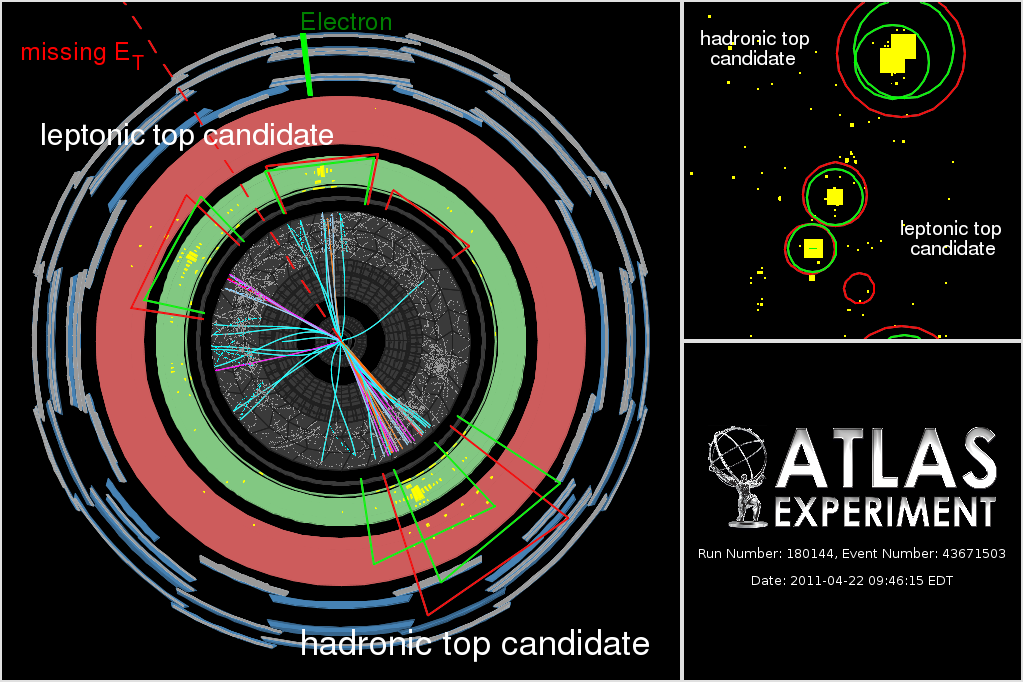
We devoted most of the second half of 2010 and of 2011 to a search for a resonance in top pair production using a selection and reconstruction algorithm developed especially for boosted top quarks. An example is given in the figure below. The classical algorithms for selection and reconstruction of top quark pairs (in the lepton+jets final state) would be looking for a lepton, a neutrino and four jets. Lepton, neutrino and one jet correspond to one top quark, a further three jets to the second. In the upper half of the image we see one of the top quarks decay to a lepton (an electron in this case), a neutrino (reconstructed as missing energy) and a jet. This seems pretty classical, but is not quite so. Instead of using the fact that they must sum up to the top quark mass to select the correct jet, we simply pick the one closest to the lepton. The boost of the top quark keeps the decay products together, ensuring that this is indeed the correct jet. Things get more unorthodox when we search for the other top quark. The classical approach needs three more jets. This event, and may like it, clearly does not meet that criterion. That's exactly the situation our algorithm is designed for. We are able to select this event by reconstructing the second top quark as a single jet. If you look closely, you can actually see it has some substructure. This is a result of the fact that these are actually three jets that got so close they merged. We use an analysis of the substructure of this jet to discard events with a lepton, a neutrino and a couple of ordinary jets, that are copiously produced at the LHC through boring Standard Model processes.
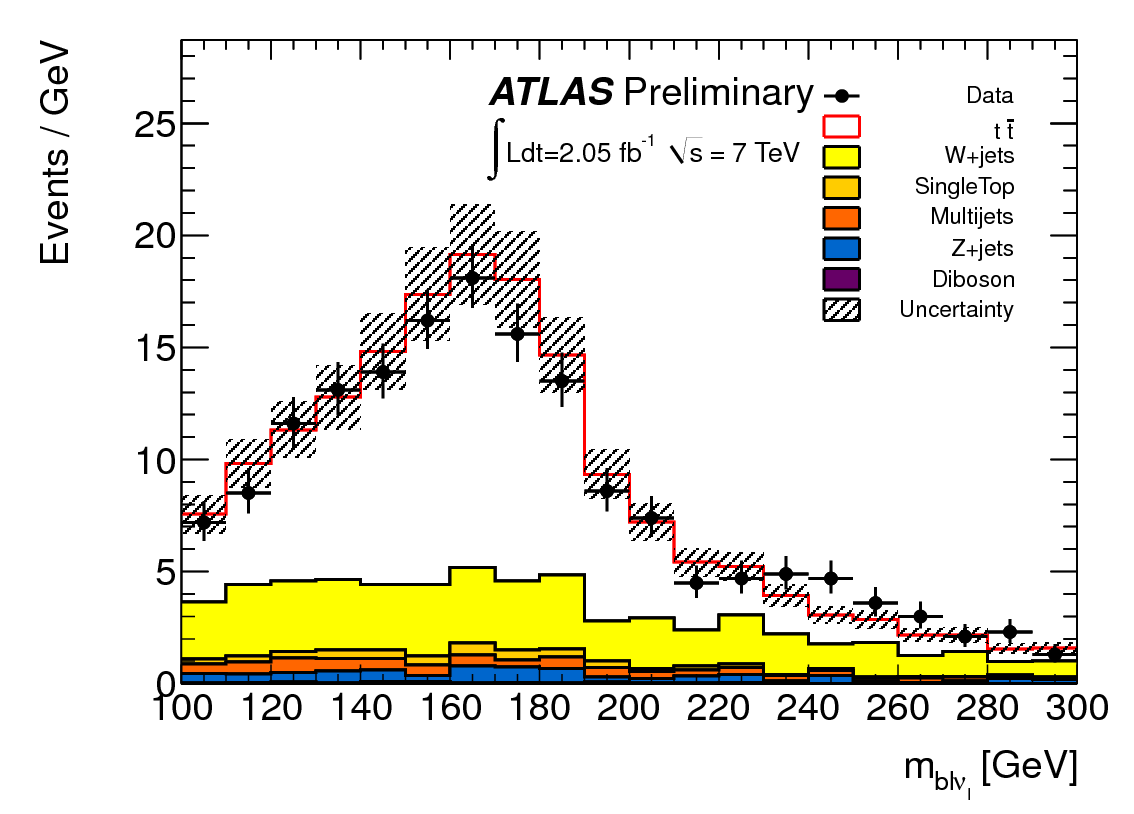 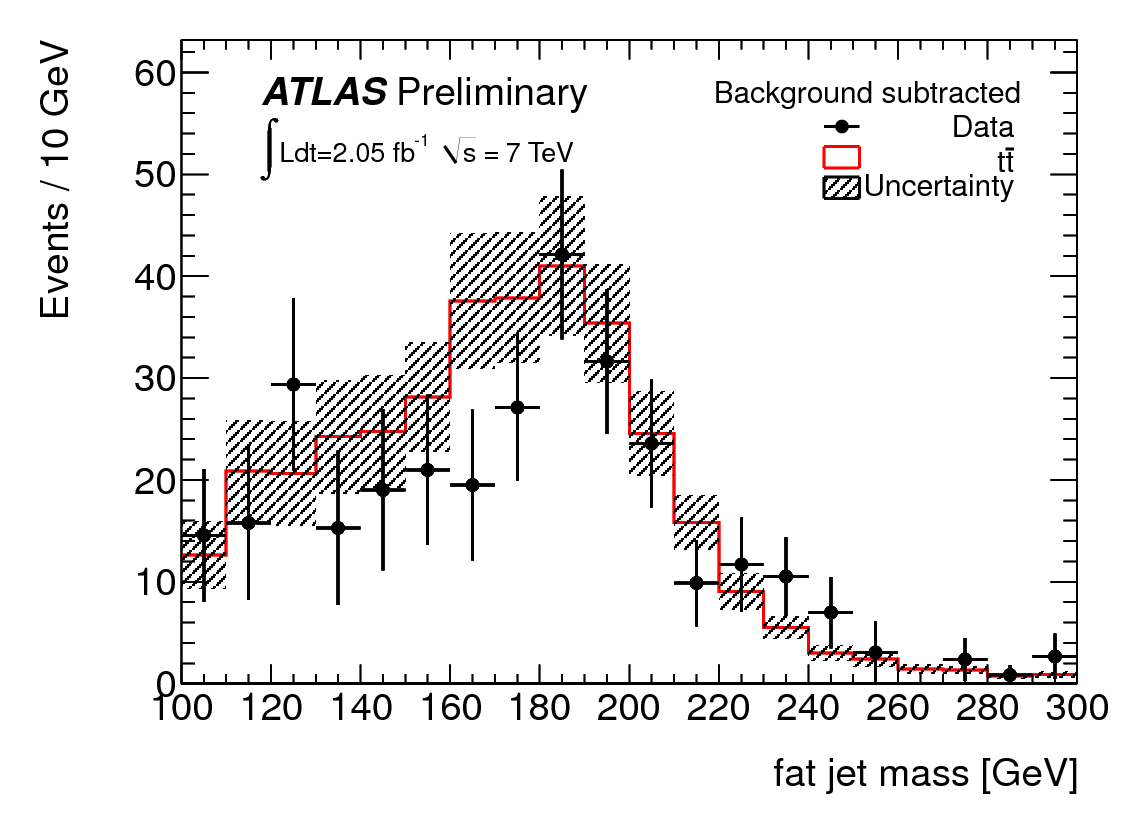
With our selection we reduce the boring Standard Model processes by orders of magnitude. What we are then left with is an irreducible background of collisions that gave rise to a pair of top quarks produced through known processes and, hopefully, a few events due to some new process. We build a template for the expected population of our selection of events using fancy simulations. Then, the first thing we do is check that the all the well-known features of events with top quarks and other known particles are there. The mass of the lepton-neutrino-jet system, for instance, must show a peak at the well-known value of the top quark mass. In the leftmost figure above you see the peak. It's a bit washed out by the experimental resolution, but it is definitely at the right value (the top quark mass is approx 174 GeV). That's not a spectacular result, but it confirms that our estimate of the what the background looks like is approximately correct. The peak in the rightmost figure is already a lot more fun. This is again the top mass peak, but this time in the distribution of the mass of a jet. To see it more clearly we have subtracted off other backgrounds and raised the momentum cut on the jets to 350 GeV. It's not the world's narrowest and sleakest mass peak, but, then again, it's the first time we have been able to isolate such a mass peak!
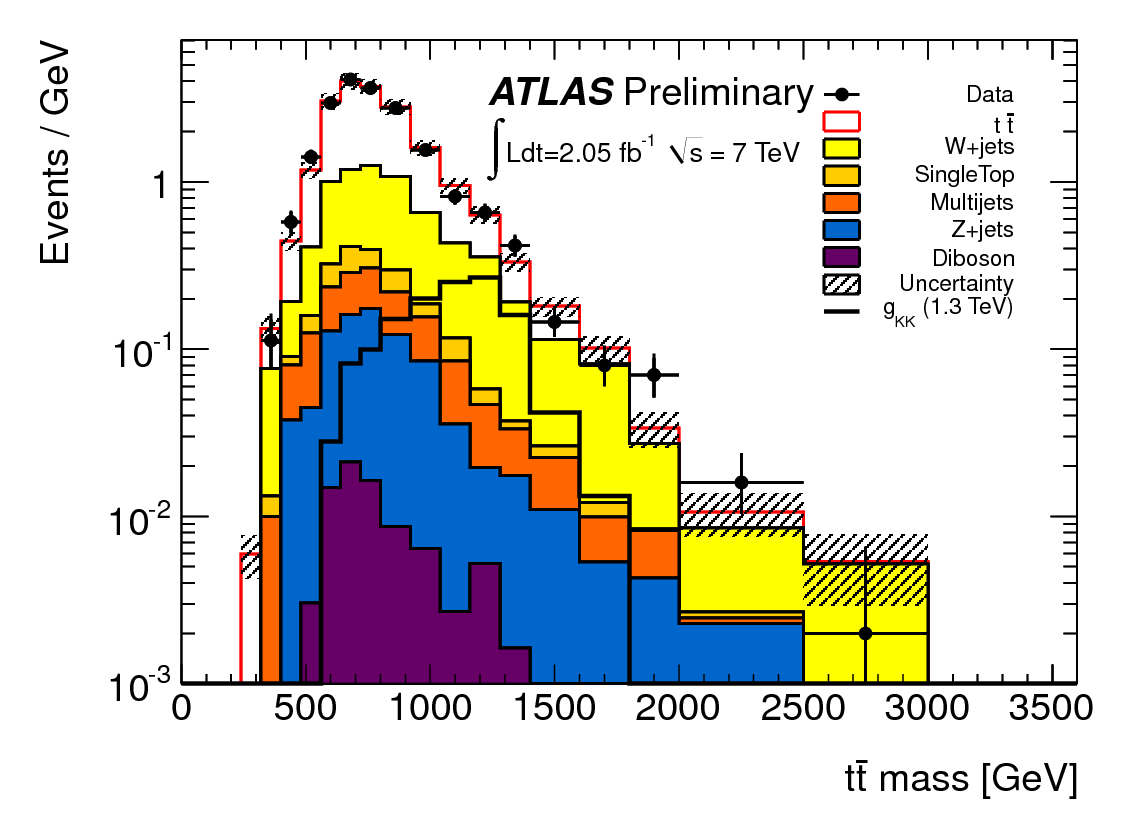 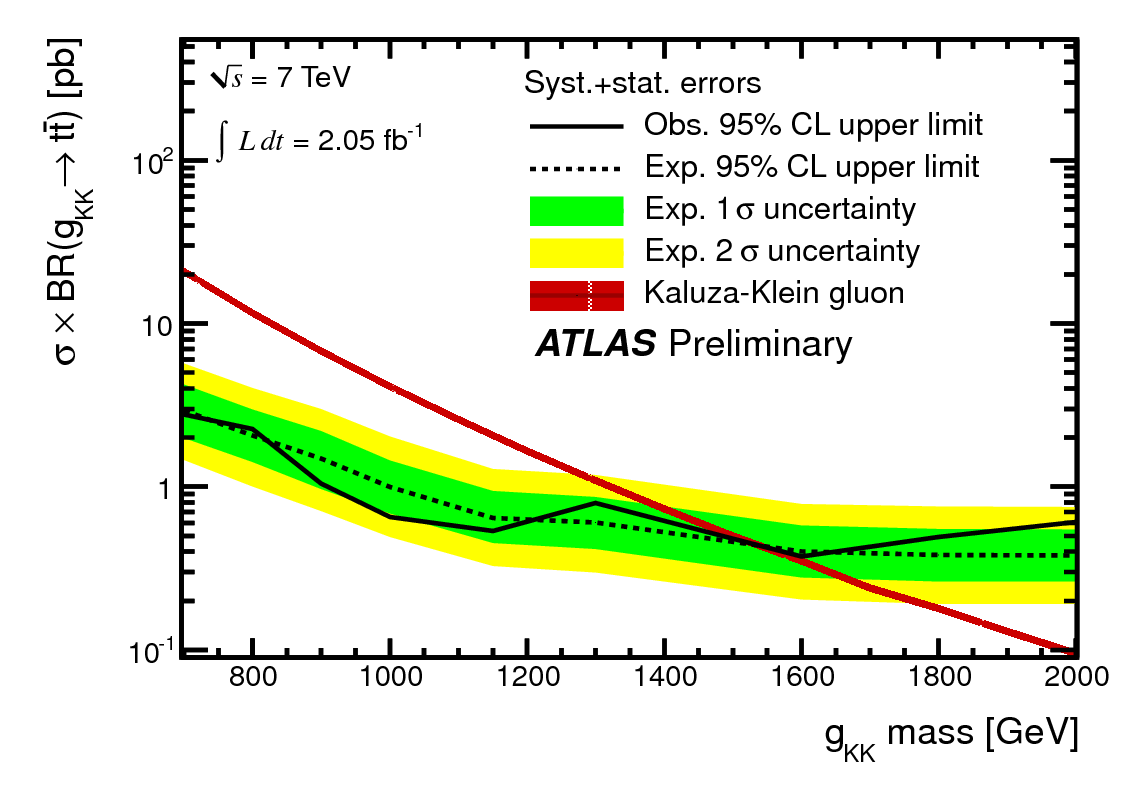
The most exciting moment in the search is when we construct the leftmost figure above. This shows the mass spectrum of all reconstructed top quark pairs. A new particle would stand out a little bump on the smooth background distribution. It's also possible that the new state manifests itself as a diffuse excess in the high-mass tail. In our distribution, there is a little excess at around 1800 GeV. Could it be new physics? A statistical analysis shows that if it is the start of something beautiful, we need to work a lot harder (and more data) to get it out. The statistical significance of the bump is 1.4 standard-deviations. That means that something like this will show up due to statistical fluctuations, even if no new physics exists, somewhere once every 5 or so times we do this experiment. That's definitely not good enough to get very excited. Most likely, this little excess will evaporate as soon as we add more data. To keep people from getting excited too soon too often we have a rule that says one needs 5 standard deviations to claim discovery.
So, no discovery. Now comes the part where we have to go and tell other physicists that we didn't find anything. We must specify somehow what kind of new particles would have shown up in our analysis, but didn't. We will say that sort of object is excluded (or disfavoured). We interpret our result in the Randall-Sundrum model I mentioned before. For several masses of the new particle we figure out whether we would have seen a significant signal. If we would have seen something, that mass is excluded. If the particle could have gone unnoticed because our analysis is not sufficiently sensitive, the mass point is still alive. The rightmost figure above summarizes the result of this exercise. Low masses, where the red curve is above the continuous black line are excluded. For approximately 1.5 TeV the two lines cross. That's where the rate of new particles becomes so small that our search becomes too insensitive to see a signal. Conclusion: the new particle must be heavier than 1.5 TeV.
|